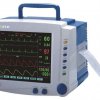
Applications
These devices are mostly used in intensive care and other hospital departments to monitor patients in their beds. They are also found in emergency services. ECG, respiration rate, blood pressure, temperature and other data can be measured. Specialized versions include fetal, cardiac output and neuromuscular monitors. There are also veterinary models.
Technologies
Most of these machines are compact, some with a handle for easy transport. Those with a touchscreen offer enhanced ergonomic characteristics. Wireless network-ready versions are useful for transmitting data to central monitoring systems in hospitals so that multiple patients may be monitored remotely.
How to choose
Choice depends on the number and type of parameters to be monitored.
Features and Benefits
- 10.4” High Resolution Color TFT LCD
- 1-8 Channel Waveform Display
- 7 Leads ECG Waveform Display; ST Segment Analysis
- Defibrillation and ESU Protection
- OxyCRG diagram, Drug Dose Calculation
- Venous Punch
- Flexible Parameter Configuration
- ECG Cable: 5 leadwires
- Lead Section: I, II, III
- Gain(mm/mV): 1/4, 1/2, 1, 2, 4
-
Frequency Response:
- Diagnosis: 0.05~100Hz
- Monitor: 0.5~40Hz
- Surgery: 1.0~25Hz
- Sweep Speed(mm/sec): 12.5, 25, 50
- Heart Rate Range: 0~350bpm
- Heart Rate Accuracy: ±1%
- Respiration Rate Measurement Range: 0~120bpm
- Respiration Rate Accuracy: ±1bpm or 5%(choice max)
- Respiration Rate Resolution: 1bpm
- CO2 Measurement Range: 0~10.0%
- CO2 Accuracy: ±2mmHg or 5%(choice max)
- CO2 Response Time: 180ms
Source:Solaris Medical

